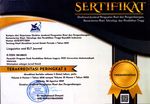ANALYSIS OF CLASSROOM INTERACTION IN EFL CLASS
Abstract
This study was to find out classroom interaction types and how those types emerge in the language teaching process. The research design was a qualitative descriptive. Participants of the research were an English teacher and 25 eight grade students of MTs-Al Raisiyah Sekarbela. The results of the study showed that there were seven types of classroom interactions which were teacher-whole class, teacher- an individual student, teacher-groups of students, student- teacher, student-student, student-whole class, and student-groups of students. The interaction occurred through teacher talk, questioning, giving feedback and discussion.
Keywords
Full Text:
PDFReferences
Brown, H. D. (2001). Teaching by Principles: An Interactive Approach to Language Pedagogy. Second Edition. New York: Addison Wesley Longman, Inc.
Cohent.I: 2011: Teacher-.student interaction in classrooms of students with specific learning difficulties learning English as a foreign language: equinox publishing
Douglas. C. A: 2006: Classroom oral interaction in foreign language lessons implications for teacher development.
Dagarin.M:2004:C1assroom interaction and communication strategies in learning English as foreign:138
Febi.g.p:2013:Conducted research entitled "An analysis of classroom interaction by using Flanders interaction analysis categories system (FIAC) technique
Jack R. Fraenkel and Norman E.Wallen. 2006. How to Design and Evaluate Research in Education. San Francisco: McGraw-Hill companies.
Mingzhi, X. :2005: Enhancing interaction in our EFL classroom. CELEA Journal Vol. 28 No. 2, pp. 56-62
Mulyadi.D:2001: Teacher talk modes in English as a foreign language classroom interaction
Murdech.Y:1990: Observation of an English Language Classroom
Mujahidah: 2011: The descriptive study on the classroom interaction during the
English-teaching learning process
Moskowitz, G. (1971). Interaction Analysis: A Mew Modern Language for
Supervisors. In: Brown (2001). Teaching by Principles: an Interactive Approach to Language Pedagogy. Second Edition. New York: Addison Wesley Longman, Inc.
Nazara, S:2010: Students’ perception on EFL speaking skill development: academia.edu/776982/Students_Perception_on_EFL_Speaking_Skill_Develo pment Riani.P.T:2013:An analysis of teacher talk and student talk in in English for young learners (EYL)
Sandelowsky.M:2000:Focus on research methods.
Sinta.n.h :2014: in her research entitled Classroom interaction analysis in the FFL
speaking class”
Sugiono:2014 : Metode penelitian pendidikan.-pendekatan kuantiatif,kualitatif', R
dan D: 117-118: published:Alfabeta Bandung
Tuan, L.T., & Nhu, N.T.K. :2010:. Theoretical review on oral communication in EFL
classrooms. Studies in Literature and Language Journal Vol. 1., No. 4, 2010,
pp. 29-48.
Thapa, C. B. & Lin, A. M. Y. (2013). Interaction in English language classrooms to
enhence students language learning. Retrieved April 12, 2015 from http://neitaclioutari.wordpress.com./20I3/0/0I/interaction-in-englisblaiiguage- classrooms-to-enhance-nepalese-students-language-learning
Yassmine.P:2009: Classroom discourse analyzing teacher learner interaction in Iranian EFL task based haled of classroom
Xiao.L:2014: Investigating the communicativeness of classroom teacher-student interaction from a conversation analysis perspective.
DOI: https://doi.org/10.31764/leltj.v3i1.822
Refbacks
- There are currently no refbacks.
Copyright (c) 2019 Linguistics and English Language Teaching Journal

This work is licensed under a Creative Commons Attribution-ShareAlike 4.0 International License.
_____________________________________________________
Linguistics and ELT Journal
p-ISSN 2339-2940 | e-ISSN 2614-8633

LELTJ is licensed under a Creative Commons Attribution-ShareAlike 4.0 International License.
_____________________________________________________
LELTJ is abstracting & indexing in the following databases:
_____________________________________________________
LELTJ Editorial Office:













